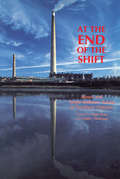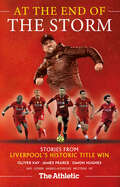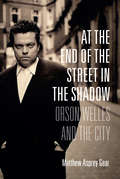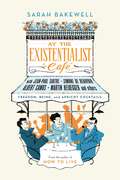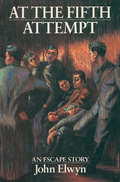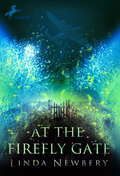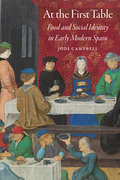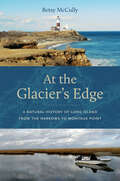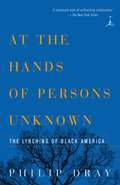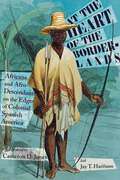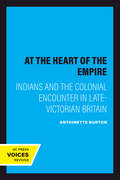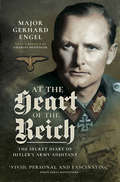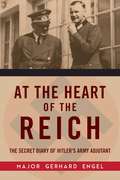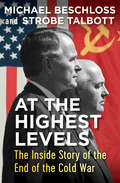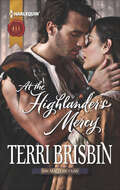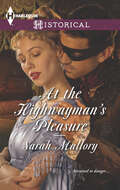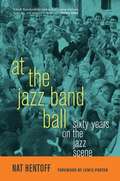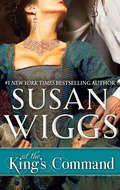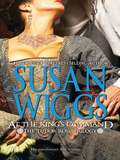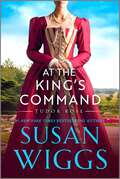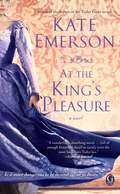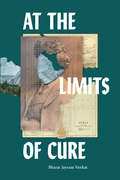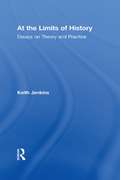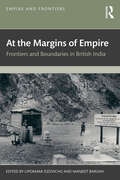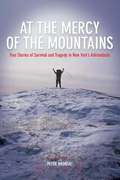- Table View
- List View
At the End of the Shift: Mines and Single-Industry Towns in Northern Ontario
by Ashley Thomson Matt BrayMining has played a formative role in the history of Northern Ontario. It has been one of the key generators of wealth in the area since the mid-19th century, and is also responsible for much of the urban development of Ontario’s northland. The twelve papers published here came out of the second annual confernce of Northern Ontario research and development held in 1990. The papers are grouped into four sections, the early years; the era of government intervention; the present and finally the future and what can be done to maintain the commnities.
At the End of the Storm: Stories from Liverpool's Historic Title Win
by James Pearce Simon Hughes Oliver KayA collection of articles from the writers of The Athletic detailing Liverpool F.C.’s 2019–2020 championship season.As Liverpool ended their thirty-year wait to be crowned champions of England, they were followed by their equivalent from the world of sports writing: a team of elite talents, assembled to leave all competition trailing in their wake. This is the story of Liverpool’s title win in the longest season, as told by the writers of The Athletic, with their blend of inside access and expert analysis; great ideas and beautiful writing.Articles include profiles of each of Liverpool’s title winners by their former youth team coaches; Oliver Kay watches Sadio Mane score against Manchester City in the company of the striker’s family, in his hometown in Senegal; James Pearce spends 90 minutes analysing Virgil van Dijk; plus there are exclusive interviews with Jurgen Klopp, and the club’s US owners.Read the stories behind a unique and historical season from a team of writers every bit as good as the footballers they were following.
At the End of the Street in the Shadow: Orson Welles and the City
by Matthew Asprey GearThe films of Orson Welles inhabit the spaces of cities—from America's industrializing midland to its noirish borderlands, from Europe's medieval fortresses to its Kafkaesque labyrinths and postwar rubblescapes. His movies take us through dark streets to confront nightmarish struggles for power, the carnivalesque and bizarre, and the shadows and light of human character. <P><P>This ambitious new study explores Welles's vision of cities by following recurring themes across his work, including urban transformation, race relations and fascism, the utopian promise of cosmopolitanism, and romantic nostalgia for archaic forms of urban culture. It focuses on the personal and political foundation of Welles's cinematic cities—the way he invents urban spaces on film to serve his dramatic, thematic, and ideological purposes.The book's critical scope draws on extensive research in international archives and builds on the work of previous scholars. Viewing Welles as a radical filmmaker whose innovative methods were only occasionally compatible with the commercial film industry, this volume examines the filmmaker's original vision for butchered films, such as The Magnificent Ambersons (1942) and Mr. Arkadin (1955), and considers many projects the filmmaker never completed—an immense "shadow oeuvre" ranging from unfinished and unreleased films to unrealized treatments and screenplays.
At the Existentialist Café: Freedom, Being, and Apricot Cocktails
by Sarah BakewellGreat philosophy meets powerful biography in this entertaining and immensely readable portrait of mid-20th century Paris and the fascinating characters of Sartre, de Beauvoir, Camus, and their circle, who loved and hated, drank and debated with each other--and forever changed the way we think about thinking.<P><P> At the Existentialist Café is a thrilling look at the famous group of post-war thinkers who became known as the Existentialists: Sartre, de Beauvoir, Camus, Heidegger, and their circle. Starting with Paris after the devastation of the Second World War, Sarah Bakewell (winner of the National Book Critics Circle Award for her previous book) takes us inside the passionate debates and equally passionate lives of these brilliant, if flawed, characters. Here is a wonderful, vibrant look at the social, artistic and political currents that shaped the existentialist movement--a mode of thinking and being that, as Bakewell vividly shows, deeply affects us today. <P> Never has the story of this influential group, and especially that of the legendary relationship between Sartre and de Beauvoir, been told with such verve and sweep, weaving personal life with social upheaval and the universal quest for understanding.
At the Fifth Attempt: An Escape Story
by John ElwynThis tells the story of a soldier caught before the evacuation at Dunkirk, and his daring escape and life along the way.
At the Firefly Gate
by Linda NewberyHenry has always felt like an outsider and things are about to get worse when his family moves to the countryside and the prospect of a new school looms. He retreats more and more into his shell, until he meets Dottie, a frail old lady, who has tremendous spirit. He feels as though he knows her, as though they have been friends for many years. And as she tells him about her wartime romance with a Royal Air Force navigator also named Henry, our Henry is drawn into that world. In a series of mysterious, sometimes frightening events he re-enacts Henry's life . . . and learns that despite being dreadfully afraid, Henry acted heroically at the cost of his own life. Only our Henry knows the true story and it shows him a way through his own self-doubts and misgivings. From the Hardcover edition.
At the First Table: Food and Social Identity in Early Modern Spain (Early Modern Cultural Studies)
by Jodi CampbellResearch on European food culture has expanded substantially in recent years, telling us more about food preparation, ingredients, feasting and fasting rituals, and the social and cultural connotations of food.At the First Table demonstrates the ways in which early modern Spaniards used food as a mechanism for the performance of social identity. People perceived themselves and others as belonging to clearly defined categories of gender, status, age, occupation, and religion, and each of these categories carried certain assumptions about proper behavior and appropriate relationships with others. Food choices and dining customs were effective and visible ways of displaying these behaviors in the choreography of everyday life. In contexts from funerals to festivals to their treatment of the poor, Spaniards used food to display their wealth, social connections, religious affiliation, regional heritage, and membership in various groups and institutions and to reinforce perceptions of difference. Research on European food culture has been based largely on studies of England, France, and Italy, but more locally on Spain. Jodi Campbell combines these studies with original research in household accounts, university and monastic records, and municipal regulations to provide a broad overview of Spanish food customs and to demonstrate their connections to identity and social change in the sixteenth and seventeenth centuries.
At the Glacier’s Edge: A Natural History of Long Island from the Narrows to Montauk Point
by Betsy McCullyVast salt marshes, ancient grasslands, lush forests, pristine beaches and dunes, and copious inland waters, all surrounded by a teeming sea. These are probably not the first things you imagine when you think of Long Island, but just beyond its highways and housing developments lies a stunning landscape full of diverse plant and animal life. Combining science writing, environmental history, and first-hand accounts from a longtime resident, At the Glacier’s Edge offers a unique narrative natural history of Long Island. Betsy McCully tells the story of how the island was formed at the end of the last ice age, how its habitats evolved, and how humans in the last few hundred years have radically altered and degraded its landscape. Yet as she personally recounts the habitat losses and species declines she has witnessed over the past few decades, she describes the vital efforts that environmental activists are making to restore and reclaim this land—from replanting salt marshes, to preserving remaining grasslands and forests, to cleaning up the waters. At the Glacier’s Edge provides an in-depth look at the flora, fauna and geology that make Long Island so special.
At the Hands of Persons Unknown: The Lynching of Black America
by Philip DrayWinner of the Southern Book Critics Circle Award for Nonfiction. This extraordinary account of lynching in America, by acclaimed civil rights historian Philip Dray, shines a clear, bright light on American history's darkest stain--illuminating its causes, perpetrators, apologists, and victims. Philip Dray also tells the story of the men and women who led the long and difficult fight to expose and eradicate lynching, including Ida B. Wells, James Weldon Johnson, Walter White, and W. E. B. Du Bois.
At the Heart of the Borderlands: Africans and Afro-Descendants on the Edges of Colonial Spanish America (Diálogos Series)
by Cameron D. Jones and Jay T. HarrisonAt the Heart of the Borderlands is the first book-length study of Africans and Afro-descendants in the frontiers of Spanish America. While people of African descent have formed part of most borderlands&’ histories, this study recognizes and explains their critical contribution to the formation of frontier spaces. Lack of imperial control coupled with Spain&’s desperation for settlers and soldiers in frontier areas facilitated the social mobility of Afro-descendants. This need allowed African descendants to become not just members of borderland societies but leaders of it as well. They were essential actors in helping to shape the limits of the Spanish empire. Africans and Afro-descendants built, opposed, and shaped Spanish hegemony in the borderlands, taking on roles that would have been impossible or difficult in colonial centers due to the socio-racial hierarchy of imperial policies and practices.
At the Heart of the Empire: Indians and the Colonial Encounter in Late-Victorian Britain
by Antoinette BurtonAntoinette Burton focuses on the experiences of three Victorian travelers in Britain to illustrate how "Englishness" was made and remade in relation to imperialism. The accounts left by these three sojourners—all prominent, educated Indians—represent complex, critical ethnographies of "native" metropolitan society and offer revealing glimpses of what it was like to be a colonial subject in fin-de-siècle Britain. Burton's innovative interpretation of the travelers' testimonies shatters the myth of Britain's insularity from its own construction of empire and shows that it was instead a terrain open to continual contest and refiguration.Burton's three subjects felt the influence of imperial power keenly during even the most everyday encounters in Britain. Pandita Ramabai arrived in London in 1883 seeking a medical education and left in 1886, having resisted the Anglican Church's attempts to make her an evangelical missionary. Cornelia Sorabji went to Oxford to study law and became the first Indian woman to be called to the Bar. Behramji Malabari sought help for his Indian reform projects in England, and subjected London to colonial scrutiny in the process. Their experiences form the basis of this wide-ranging, clearly written, and imaginative investigation of diasporic movement in the colonial metropolis.
At the Heart of the Reich: The Secret Diary of Hitler's Army Adjutant
by Major Gerhard EngelVivid, personal and fascinating. Simon Sebag MontefioreGerhard Engel was Hitlers Army Adjutant from March 1938 to March 1943. During this time he kept a diary, and after the war he added material to shed further light on key events and decisions.He discloses the decision-making process behind many of the key operations and addresses the intrigues within Hitlers inner circle, recounting the Fhrers conversations with Halder, Guderian and Brauchitsch. Engel also details Hitlers views on German Jews, and in the final part of the diary he covers the war against Russia. Increasingly, towards the end, he depicts Hitler as a vacillating and contrary man.At the Heart of the Reich offers a unique and intimate view of Hitler and his closest aides. It reveals the mechanisms and personalities of the centre of the Third Reich, and provides a fresh perspective of the Nazi leadership.
At the Heart of the Reich: The Secret Diary of Hitler’s Army Adjutant
by Gerhard EngelA revealing account of Hitler's thoughts and actions throughout World War II from one of his closest aides.Major Gerhard Engel was Hitler's army adjutant from 1938 to 1943. During his years with Hitler, Engel kept a diary. After the war, he added material to shed further light on certain events, military and political decisions, and Hitler's attitude to particular problems. His diary covers the decision-making process behind crucial military actions, including the annexation of Austria, the invasion of Czechoslovakia, and the war against Russia. He also addresses intrigue within Hitler's inner circle and his casual conversations with other key Nazi figures.At the Heart of the Reich sheds important light on the Fuhrer's core beliefs. It includes the statement made by Hitler in 1941, "I am now as before a Catholic." It also details his views on German Jews and dwells on the extent to which they served in the Wehrmacht. Engel also addresses the deportation of Jews from Salonika and Hitler's order to Himmler to select a destination, the details of which Hitler was apparently unconcerned with. The final part of the diary is mostly devoted to the war against Russia. Engel's reports confirm that the master plan was to take Leningrad and Rostov, then close pincers behind Moscow. The plan was frustrated by senior army commanders'' lack of enthusiasm and Hitler's failure to exert firm leadership. Engel depicts Hitler as a vacillating, contrary man. It is not unlikely that this encouraged his generals to impose themselves and argue their plan to rush Moscow, which ultimately contributed to the defeat of the Third Reich.Skyhorse Publishing, along with our Arcade, Good Books, Sports Publishing, and Yucca imprints, is proud to publish a broad range of biographies, autobiographies, and memoirs. Our list includes biographies on well-known historical figures like Benjamin Franklin, Nelson Mandela, and Alexander Graham Bell, as well as villains from history, such as Heinrich Himmler, John Wayne Gacy, and O. J. Simpson. We have also published survivor stories of World War II, memoirs about overcoming adversity, first-hand tales of adventure, and much more. While not every title we publish becomes a New York Times bestseller or a national bestseller, we are committed to books on subjects that are sometimes overlooked and to authors whose work might not otherwise find a home.
At the Highest Levels: The Inside Story of the End of the Cold War
by Michael Beschloss Strobe TalbottThe landmark story of Bush-Gorbachev diplomacy: &“No one has ever given as complete and compelling an account of the higher reaches of foreign policy&” (Time). December 1989. The Berlin Wall had fallen. Millions across the Eastern Bloc were enjoying new freedoms. And the USSR was falling apart. But the peaceful end of the Cold War was far from assured, requiring the leaders of rival superpowers to look beyond the animosities of the past and embrace an uncertain future. At the Highest Levels is the fascinating story of that unlikely partnership, a real-time exposé of the negotiations between US President George H. W. Bush and Soviet Premier Mikhail Gorbachev. Granted extraordinary access to private conversations and closed-door meetings at the Kremlin, White House, Pentagon, CIA, and KGB, Michael Beschloss and Strobe Talbott reveal the high-stakes international diplomacy that ended the nuclear arms race and decades of proxy wars. The result is &“an accurate first draft of the Cold War&’s last days,&” wrote David Remnick in the New Yorker, &“filled with gaudy historical riches.&” Each an acclaimed author in his own right, Beschloss and Talbott together deliver journalism at its best: an &“intimate and utterly absorbing&” record of this critical meeting of minds (The New York Times).
At the Highlander's Mercy: The Highlander's Stolen Touch At The Highlander's Mercy The Highlander's Dangerous Temptation Yield To The Highlander (The MacLerie Clan)
by Terri BrisbinA clan chief’s desperate plan to reunite his people may also rekindle an unforgettable passion in this medieval Scottish romance.To regain control of his fractured clan, Robert Matheson needs bargaining power. Taking Lilidh MacLerie hostage should give him plenty. But Lilidh is no ordinary captive. She’s the woman he once loved—and rejected!Rob’s touch is etched permanently into Lilidh’s memory. Unaware that he was forced to repudiate their love, she has never forgotten the man who broke her heart all those years ago. Now, looking into the eyes of her captor, she no longer recognizes this fearsome leader. She should be afraid—there’s no telling what he will do. But something about him excites and unnerves her in equal measure . . . .
At the Highwayman's Pleasure
by Sarah MalloryA masked vigilante lights a fire in the heart of a beautiful actress in this thrilling historical adventure.Captivated by the dark rider . . .Embittered by injustice, Ross Durden leads a double life: gentleman farmer by day, roguish highwayman by night. He has sworn to right the wrongs of the past, but danger lurks around every corner—not least when he sets eyes on the beautiful daughter of his sworn enemy.Celebrated actress Charity Weston is no stranger to disguises herself. But when a darkly daring masked man steals a kiss, she is drawn into a web of intrigue even she could never have imagined.Praise for At the Highwayman’s Pleasure“Revenge. Redemption. Romance. Mallory’s latest . . . is about an actress, a highwayman, and an evil duo who so deserve their comeuppance! Readers will enjoy the characters and the plot twists.” —RT Book Reviews
At the Jazz Band Ball: Sixty Years on the Jazz Scene
by Nat HentoffThe book shows how jazz and education are a vital partnership, how free expression is the essence of liberty, and how social justice issues like health care and strong civil rights and liberties keep all the arts--and all members of society--strong.
At the King's Command
by Susan WiggsTravel back to the glittering Tudor court with #1 New York Times bestselling author Susan Wiggs in her beloved Tudor Rose Trilogy. Frustrated by his own failures at matrimony, King Henry VIII punishes an insolent nobleman by commanding him to marry the vagabond woman caught stealing his horse. Stephen de Lacey is a cold and bitter widower, long accustomed to the sovereign's capricious and malicious whims. He regards his new bride as utterly inconvenient…though undeniably fetching. But Juliana Romanov is no ordinary thief—she is a Russian princess forced into hiding by the traitorous cabal who slaughtered her family. One day she hopes to return to Muscovy to seek vengeance. What begins as a mockery of a marriage ultimately blossoms into deepest love. Originally published in 2009
At the King's Command (Tudor Rose #1)
by Susan WiggsFrustrated by his own failures at matrimony, King Henry VIII punishes an insolent nobleman by commanding him to marry the vagabond woman caught stealing his horse. Stephen de Lacey is a cold and bitter widower, long accustomed to the sovereign's capricious and malicious whims. He regards his new bride as utterly inconvenient...though undeniably fetching.But Juliana Romanov is no ordinary thief-she is a Russian princess forced into hiding by the traitorous cabal who slaughtered her family. One day she hopes to return to Muscovy to seek vengeance.What begins as a mockery of a marriage ultimately blossoms into deepest love.
At the King's Command (Tudor Rose #1)
by Susan WiggsIn this steamy historical romance from #1 New York Times bestselling author Susan Wiggs, a jaded English nobleman and a disgraced Russian princess are forced into a whirlwind romance of secrets, passion, and mystery.Frustrated by his own failures at matrimony, King Henry VIII punishes an insolent nobleman by commanding him to marry the vagabond woman caught stealing his horse. Stephen de Lacey is a cold and bitter widower, long accustomed to the sovereign's capricious and malicious whims. He regards his new bride as utterly inconvenient…though undeniably fetching.But Juliana Romanov is no ordinary thief—she is a Russian princess forced into hiding by the traitorous cabal who slaughtered her family. One day she hopes to return to Muscovy to seek vengeance.What begins as a mockery of a marriage ultimately blossoms into deepest love.Books in the Tudor Rose Trilogy:At the King's CommandThe Maiden's HandAt the Queen's SummonsPreviously published.
At the King's Pleasure
by Kate EmersonThe fourth novel in Kate Emerson's well-reviewed series set in Tudor England--based on a real life member of the royal court of Henry VIII. Following the acclaimed By Royal Decree, Pleasure Palace, and Between Two Queens, Kate Emerson again plucks a real figure from history in this lushly detailed tale featuring Lady Anne Stafford--who is torn between her husband and another man. History remembers Lady Anne Stafford as the woman who cheated on her husband with both King Henry VIII and his companion, Sir William Compton. Lady Anne was indeed in love with two men at the same time....but the king wasn't one of them. Lady Anne's complex and heart-wrenching romantic relationships are at the core of this riveting tale that masterfully blends romance, drama, and historical detail as only Kate Emerson can.
At the Limits of Cure (Critical Global Health: Evidence, Efficacy, Ethnography)
by Bharat Jayram VenkatCan a history of cure be more than a history of how disease comes to an end? In 1950s Madras, an international team of researchers demonstrated that antibiotics were effective in treating tuberculosis. But just half a century later, reports out of Mumbai stoked fears about the spread of totally drug-resistant strains of the disease. Had the curable become incurable? Through an anthropological history of tuberculosis treatment in India, Bharat Jayram Venkat examines what it means to be cured, and what it means for a cure to come undone. At the Limits of Cure tells a story that stretches from the colonial period—a time of sanatoria, travel cures, and gold therapy—into a postcolonial present marked by antibiotic miracles and their failures. Venkat juxtaposes the unraveling of cure across a variety of sites: in idyllic hill stations and crowded prisons, aboard ships and on the battlefield, and through research trials and clinical encounters. If cure is frequently taken as an ending (of illness, treatment, and suffering more generally), Venkat provides a foundation for imagining cure otherwise in a world of fading antibiotic efficacy.
At the Limits of History: Essays on Theory and Practice
by Keith Jenkins"Why bother with history? Keith Jenkins has an answer. He helps us re-think the "end of history", as signalled by postmodernity. Readers may disagree with him, but he never fails to provoke debate about the future of the past." Joanna Bourke, Professor of History, Birkbeck College Keith Jenkins’ work on historical theory is renowned; this collection presents the essential elements of his work over the last fifteen years. Here we see Jenkins address the difficult and complex question of defining the limits of history. The collection draws together the key pieces of his work in one handy volume, encompassing the ever controversial issue of postmodernism and history, questions on the end of history and radical history into the future. Exchanges with Perez Zagorin and Michael Coleman further illuminate the level of debate that has surrounded postmodernism, and which continues to do so. An extended introduction and abstracts which contextualize each piece, together with a foreword by Hayden White and an afterword by Alun Munslow, make this collection essential reading for all those interested in the theory and practice of history and its development over the last few decades.
At the Margins of Empire: Frontiers and Boundaries in British India (Empire and Frontiers)
by Lipokmar Dzüvichü and Manjeet BaruahEmpire building in British India was inseparably tied to the processes of frontier-making and the creation of boundaries. Through a range of complex practices and developments, the constitution of these spaces took shape at various historical conjunctures. The making of these spaces was also shaped by a variety of imperial concerns, including local and global processes, connections, and entanglements. Focusing on the period between the 19th and the early 20th centuries, this book looks at how the dynamics of frontier and boundary creation were shaped by a variety of agents, institutions, infrastructure and technologies, events, economy, travel, forms of representation, and imperial rivalries. The role of capital, war, and violence was also intrinsic to the creation of such spaces. Further, societies in these spaces responded to these processes in various ways. The book examines how they negotiated and mediated these complex developments of modern space-making in multiple ways at the margins of empire.Part of the Empire and Frontiers series, this book will be of interest to researchers and readers of history, anthropology, cultural studies, social and cultural history, frontiers, boundaries and borderland studies, Himalayan studies, and studies of commodities and circulations.
At the Mercy of The Mountains: True Stories of Survival and Tragedy In New York's Adirondacks
by Peter BronskiIn this compelling book, award-winning adventure writer and former Lower Adirondack Search and Rescue team member Peter Bronski chronicles true stories of survival and tragedy, from famous historical cases during the early 20th century, to modern tales of harrowing struggle in the mountains and wilderness. Extensively researched, these gripping tales pull together historical accounts, first-hand interviews, previously untold stories and expert analysis to retrace each misadventure
